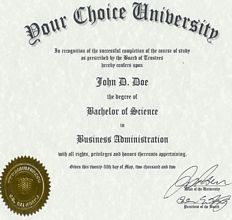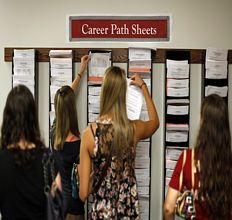Financial Aid Glossary (A - E)
When it comes to Financial Aid, Student Loans, Scholarships and Grants, oftentimes you will come across terms,
acronyms and words that you’ve never heard of. To make defining them a simple process, the Student Loan Whiz has
provided a comprehensive list of the words and phrases you’ll need to be familiar with. When it comes to financial
aid and funding your educational dreams, we have what you’re looking for, be sure and check out all of our sources
and resources on student loan debt, money for college and scholarships.
NO ADSENSE ACCOUNT SELECTED FOR
GOOGLE ADSENSE
Accrue
To accumulate. Usually this word is associated with interest on student loans.
Accrual Date
The date on which interest charges on an educational loan begin to accrue.
Achievement Tests (SAT II)
A collection of tests that measure the student's proficiency and
accumulated knowledge of specific subject areas. Different schools require different achievement tests as part of
their admissions requirements. Since March 1994, these tests are now known as the SAT II tests. There are numerous
sources to help you score high on the SAT, so make sure that you check them out!
Adjusted Available Income
In the Federal Methodology, the remaining income after the
allowances (taxes and a basic living allowance) have been subtracted.
Admit-Deny
A practice in which a school will admit marginal students, but not award them any
financial aid. Very few schools use admit-deny, because studies have shown that lack of sufficient financial aid is
a key factor in the performance of marginal students.
Advanced Placement Test (AP)
Test used to earn credit for college subjects studied in high
school. They are offered by ETS in the spring. AP tests are scored on a scale from 1 to 5 (the best possible
score).
Adverse Credit History
To be eligible for a PLUS loan, the borrower must not have an adverse
credit history. This is a modest credit check. According to the regulations at 34 CFR 682.201(c)(2), a borrower is
considered to have an adverse credit history if a recent credit report shows that
- The borrower is 90 or more days delinquent on any debt, or
- The borrower had a Title IV debt subject to a default determination, bankruptcy discharge, foreclosure,
repossession, tax lien, wage garnishment, or write-off during the five years preceding the date of the credit
report
Note that the absence of a credit history is not considered an adverse credit history. Only about a fifth to a
quarter of borrowers will be found to have an adverse credit history, meaning that more than three-quarters of
borrowers will be eligible for a PLUS loan. PLUS loans do not use any kind of a debt-to-income ratio or FICO score,
unlike private education loans.
Aggregator
An aggregator is a student who wins many scholarships with a cumulative value of
more than $100,000. Some aggregators have published books with a theme "I won a gazillion dollars for college and
you can too". Although these books contain some good advice, most students will not be able to pay for college
entirely through scholarships. Very few students win more than $100,000 in scholarships, and doing so requires a
combination of talent and luck.
Alternative Loans
See Private Student Loans.
American College Test (ACT)
One of the two national standardized college entrance
examinations used in the US. The other is the SAT. The ACT is widely used in the West and Midwest. Most
universities require either the ACT or the SAT as part of an application for admission.
Amortization
The process of gradually repaying a loan over an extended period of time
through periodic installments of principal and interest.
Appeal
A formal request to have a financial aid administrator review your aid eligibility
and possibly use Professional Judgment to adjust the figures. For example, if you believe the financial information
on your financial aid application does not reflect your family's current ability to pay (e.g., because of death of
a parent, unemployment or other unusual circumstances), you should definitely make an appeal. The financial aid
administrator may require documentation of the special circumstances or of other information listed on your
financial aid application.
Asset
An item of value, such as a family's home, business, and farm equity, real estate,
stocks, bonds, mutual funds, cash, certificates of deposit (CDs), bank accounts, trust funds and other property and
investments.
Asset Protection Allowance
A portion of your parents' assets that are not included in the
calculation of the parent contribution, as calculated by the Federal Methodology need analysis formula. The asset
protection allowance increases with the age of the parents.
Assistantship
See Graduate Assistantship.
Associate Degree
The degree granted by two-year colleges.
Award Letter
An official document issued by a school's financial aid office that lists all
of the financial aid awarded to the student. This letter provides details on their analysis of your financial need
and the breakdown of your financial aid package according to amount, source and type of aid. The award letter will
include the terms and conditions for the financial aid and information about the cost of attendance. You are
required to sign a copy of the letter, indicating whether you accept or decline each source of aid, and return it
to the financial aid office. Some schools call the award letter the "Financial Aid Notification (FAN)".
Award Year
The academic year for which financial aid is requested (or received).
Bachelor's Degree
The undergraduate degree granted by four-year colleges and
universities.
Balloon Payment
A larger than usual payment used to pay off the outstanding balance of a
loan without penalty. Not all loans allow balloon payments. Simple interest loans, like many educational loans,
generally do allow balloon payments.
Bankruptcy
When a person is declares bankruptcy, they are found to be legally insolvent and
in some cases their property is distributed amongst their creditors or otherwise administered to satisfy the
interests of his creditors. Federal student loans, however, cannot normally be discharged through bankruptcy.
Base Year
The tax year prior to the academic year (award year) for which financial aid is
requested. The base year runs from January 1 of the junior year in high school through December 31 of the senior
year. Financial information from this year is used to determine eligibility for financial aid.
Borrower
The person who applies for and is approved for a student loan.
Borrower Benefit
These are benefits provided by student loan lenders to entice students to
apply for loans. It is reported that only 20% to 25% percent of students qualify for these borrower benefits.
Budget
See Cost of Attendance.
Bursar's Office
(Also called Student Accounts Office) The university office that is
responsible for the billing and collection of university charges.
Campus Based Aid
Financial aid programs are administered by the university. The federal
government provides the university with a fixed annual allocation, which is awarded by the financial aid
administrator to deserving students. Such programs include the Perkins Loan, Supplemental Education Opportunity
Grant and Federal Work-Study. Note that there is no guarantee that every eligible student will receive financial
aid through these programs, because the awards are made from a fixed pool of money. This is a key difference
between the campus-based loan programs and the Direct Loan Program. Do not confuse the two, even though both loans
are issued through the schools.
Cancellation
Some loan programs provide for cancellation of the loan under certain
circumstances, such as death or permanent disability of the borrower. Some of the Federal student loan programs
have additional cancellation provisions. For example, if the student becomes a teacher in certain national shortage
areas, they may be eligible for cancellation of all or part of the balance of their educational loans. Repayment
assistance is available if you serve in the military; the military pays off a portion of your loans for every year
of service.
Capital Gain
An increase in the value of an asset such as stocks, bonds, mutual funds and
real estate between the time the asset was purchased and the time the asset was sold.
Capitalization
The practice of adding unpaid interest charges to the principal balance of an
educational loan, thereby increasing the size of the loan. Interest is then charged on the new balance, including
both the unpaid principal and the accrued interest. Capitalizing the interest increases the monthly payment and the
amount of money you will eventually have to repay. If you can afford to pay the interest as it accrues, you are
better off not capitalizing it. Capitalization is sometimes called compounding.
Collateral
Property that is used to secure a loan. If the borrower defaults on the loan, the
lender can seize the collateral. For example, the house purchased with the loan usually secures the mortgage.
Collection Agency
A company often hired by the lender or guarantee agency to recover
defaulted student loans. Collection agencies are bound by the Fair Debt Collection Act.
College Board
A nonprofit educational association of colleges, universities, educational
systems and other educational institutions.
College Work Study (CWS)
College Work Study is essentially nothing more than a part time
job. This term is sometimes erroneously used to refer to the Federal Work Study Program.
Color of Federal Forms
The FAFSA and SAR change color each year in a four color rotation:
Yellow (2007-2008), Orange (2008-2009), Blue (2009-2010), and Green (2010-2011), then it repeats. (Orange is
replacing Pink starting in 2008-2009 and Blue and Green swapped places. Previously the color rotation was Yellow
(2003-04), Pink (2004-05), Green (2005-06), and Blue (2006-07).) This will help you make sure you're filing the
correct form. Purple has been the stable parent color since 1999-2000.
Community Property
Community property laws specify that property is owned jointly by husband
and wife unless there is a specific agreement to the contrary (i.e., prenuptial agreements). According to IRS
Publication 555, the following is a list of Community Property states: Arizona, California, Idaho, Louisiana,
Nevada, New Mexico, Texas, Washington and Wisconsin. In addition, Alaska has community property laws.
Commuter Student
This is a student who lives at home and commutes to school every day.
Compounded Interest
Interest that is paid on both the principal balance of the loan and on
any accrued (unpaid) interest. Capitalizing the interest on an unsubsidized Stafford loan is a form of
compounding.
Consolidation Loan
(Also called Loan Consolidation) A loan that combines several student
loans into one bigger loan from a single lender. The consolidation loan is used to pay off the balances on the
other loans.
Cooperative Education
A program where the student spends time engaged in employment related
to their major in addition to regular classroom study.
Cosigner
A cosigner is a person on a loan who assumes responsibility for the loan if the
borrower fails or refuses to repay it.
Cost of Attendance (COA)
This is the total amount it should cost the student to go to
school, including tuition and fees, room and board, allowances for books and supplies, transportation, and personal
and incidental expenses. Loan fees, if applicable, may also be included in the COA. Child care and expenses for
disabilities may also be included at the discretion of the financial aid administrator. Schools establish different
standard budget amounts for students living on-campus and off-campus, married and unmarried students and in state
and out-of-state students. (Also known as the cost of education or "budget")
Credit Rating
With some student loans, a person’s credit rating is taken into consideration.
People who make all their payments on time are considered good credit risks. People who are frequently delinquent
in making their payments are considered bad credit risks. Defaulting on a loan can adversely hurt your credit
rating. Credit bureaus and credit reporting agencies provide this information to banks and businesses to help them
decide whether to issue a loan or extend credit. Your credit rating may include your payment history, a list of
current and past credit accounts and their balances, employment and personal information and a history of past
credit problems.
Custodial Parent
If a student's parents are divorced or separated, the custodial parent is
the one with whom the student lived the most during the past 12 months. The student's need analysis is based on
financial information supplied by the custodial parent.
Default
A loan is in default when the borrower fails to pay several regular installments on
time (i.e., payments overdue by 180 days) or otherwise fails to meet the terms and conditions of the loan. If you
default on a loan, the university, the holder of the loan, the state government and the federal government can take
legal action to recover the money, including garnishing your wages and withholding income tax refunds. Defaulting
on a government loan will make you ineligible for future federal financial aid, unless a satisfactory repayment
schedule is arranged, and can affect your credit rating.
Default Fee
Synonymous with Guarantee Fee.
Deferment
Occurs when a borrower is allowed to postpone repaying the loan. If you have a
subsidized loan, the federal government pays the interest charges during the deferment period. If you have an
unsubsidized loan, you are responsible for the interest that accrues during the deferment period. You can still
postpone paying the interest charges by capitalizing the interest, which increases the size of the loan. Most
federal loan programs allow students to defer their loans while they are in school at least half time. If you don't
qualify for a deferment, you may be able to get a forbearance. You can't get a deferment if your loan is in
default.
Delinquent
If the borrower fails to make a payment on time, the borrower is considered
delinquent and late fees may be charged. If the borrower misses several payments, the loan goes into default.
Dependency Status
Determines to what degree a student has access to parent financial
resources.
Dependent
For a child or other person to be considered your dependent, they must live with
you and you must provide them with more than half of their support. Spouses do not count as dependents in the
Federal Methodology. You and your spouse cannot both claim the same child as a dependent.
Direct Loans
The William D. Ford Federal Direct Loan Program (aka the Direct Loan Program)
is a federal program where the school becomes the lending agency and manages the funds directly, with the federal
government providing the loan funds. Not all schools currently participate in this program. Benefits of the program
include a faster turnaround time and less bureaucracy than the old "bank loan" program. The terms for Direct Loans
are the same as for the Stafford Loan program. For more information about Direct Loans, contact the Direct Loan
Servicing Center at 1-800-848-0979.
Disbursement
The release of loan funds to the school for delivery to the borrower. The
payment will be made co-payable to the student and the school. Loan funds are first credited to the student's
account for payment of tuition, fees, room and board and other school charges. Any excess funds are then paid to
the student in cash or by check. Unless the loan amount is under $500, the disbursement will be made in at least
two equal installments.
Discharge
To release the borrower from his or her obligation to repay the loan.
Disclosure Statement
Provides the borrower with information about the actual cost of the
loan, including the interest rate, origination, insurance, loan fees and any other types of finance charges.
Lenders are required to provide the borrower with a disclosure statement before issuing a loan.
Discount
See Loan Discount.
Doctorate
One of several degrees granted by graduate schools.
Due Diligence
If a borrower fails to make payments on their loan according to the terms of the promissory note, the federal
government requires the lender, holder or company that services the loan, to make frequent attempts to contact the
borrower (via telephone and mail) to encourage him or her to repay the loan and make arrangements to resolve the
delinquency.
Early Action
A program with earlier deadlines and earlier notification dates than the
regular admissions process. Students who apply to an early action program do not commit to attending the school if
admitted, unlike an early decision program. Ivy League schools do not allow you to apply to more than one Ivy early
action.
Early Admission
A program that allows gifted high school juniors to skip their senior year
and enroll instead in college. The term "Early Admission" is sometimes used to refer collectively to Early Action
and Early Decision programs.
Early Decision
A program with earlier deadlines and earlier notification dates than the
regular admissions process. Students who apply to an early decision program commit to attending the school if
admitted (thus, early decision can be applied to only one school). Unfortunately, this means the student has
accepted the offer of admission before they find out about the financial aid package. You should only participate
in an early decision program if the school is your first choice and you won't want to consider other schools.
Electronic Data Exchange (EDE)
Program used by participating schools to electronically
receive SARs from the federal processor. At some schools EDE allows students to electronically file their Free
Application for Federal Student Aid (FAFSA).
Educational Testing Service (ETS)
Company that produces and administers the SAT and other
educational achievement tests.
Electronic Funds Transfer (EFT)
Used by some schools and lenders to wire funds for Stafford
and PLUS loans directly to participating schools without requiring an intermediate check for the student to
endorse. The money is transferred electronically instead of using paper, and hence is available to the student
sooner. If you have a choice of funds transfer methods, use EFT.
Electronic Student Aid Report
An electronic form of the Student Aid Report.
Eligible Non-Citizen
Someone who is not a US citizen but is nevertheless eligible for
Federal student aid. Eligible non-citizens include US permanent residents who are holders of valid green cards, US
nationals, holders of form I-94 who have been granted refugee or asylum status and certain other non-citizens.
Non-citizens who hold a student visa or an exchange visitor visa are not eligible for Federal student aid.
Emancipated
To release a child from the control of a parent or guardian. Declaring a child
to be legally emancipated is not sufficient to release the parents or legal guardians from being responsible for
providing for the child's education. If this were the case, then every parent would "divorce" their children before
sending them to college. The criteria for a child to be found independent are much stricter.
Endowment
Funds owned by an institution and invested to produce income to support the
operation of the institution. Many educational institutions use a portion of their endowment income for financial
aid. A school with a larger ratio of endowment per student is more likely to give larger financial aid
packages.
Enrollment Status
An indication of whether you are a full-time or part-time student.
Generally you must be enrolled at least half-time (and in some cases full-time) to qualify for financial aid.
Entitlement
Entitlement programs award funds to all qualified applicants. The Pell Grant is
an example of such a program.
Entrance Interview
See Loan Interviews.
Equity
The dollar value of your ownership in a piece of property. See Home Equity.
Exit Interview
See Loan Interviews.
Expanded Lending Option (ELO)
Under ELO, some schools can offer higher annual and cumulative
loan limits to students receiving the Perkins Loan. The ELO is restricted to schools with a Perkins Loan default
rate of 15% or less.
Expected Family Contribution (EFC)
The amount of money that the family is expected to be
able to contribute to the student's education, as determined by the Federal Methodology need analysis formula
approved by Congress. The EFC includes the parent contribution and the student contribution, and depends on the
student's dependency status, family size, number of family members in school, taxable and nontaxable income and
assets. The difference between the COA and the EFC is the student's financial need, and is used in determining the
student's eligibility for need-based financial aid. If you have unusual financial circumstances (such as high
medical expenses, loss of employment or death of a parent) that may affect your ability to pay for your education,
tell your financial aid administrator (FAA). He or she can adjust the COA or EFC to compensate.
Brad Matheson is a professional Financial Consultant who specializes in helping businesses and individuals
resolve their debt issues. He believes that all debt problems can be solved with the right debt advice and aspires
to help Americans learn all of their debt options and exercise all of their rights. Says, Matheson, “Don't allow
the Student Loan Debt crisis or a Defaulted Student Loan to hinder or block
your career aspirations or stymie your financial dreams, There is Student Loan
Help available!”
Source: http://studentloanwhiz.com/
| 










